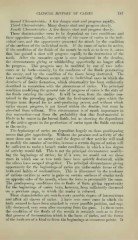Page 777 - My FlipBook
P. 777
CLINICAL HISTORY OF CARIES. 787
Second Characteristic: A few decays start and progress rapidly.
Third Characteristic : Many decays start and progress slowly.
Fourth Characteristic: A few decays start and progress slowly.
These characteristics seem to be dependent on two conditions and
tlieir opposites—namely, the activity of the cause of caries in the indi-
vidual case, and the opportunity presented for attack by the condition
of the surfaces of the individual teeth. If the cause of caries be active,
if the condition of the fluids of the mouth be such as to favor it, caries
that has gained a start will progress rapidly to the destruction of the
tooth. After the causative agent is once implanted in the dentine,
the circumstances giving or withholding opportunitt/ no longer affect
its progress. This progress may be modiHed by one of two influ-
ences or by both—namely, by the condition of the fluids penetrating
the cavity, and by the condition of the tissue being destroyed. The
latter modifying influence occurs only in individual cases in which the
dentine- is of faulty formation, which abnormality has been sufficiently
described in connection with the phenomena of caries. The princijjal
condition modifying the general rate of progress of caries is the state of
the fluids entering the cavity. It will be seen, from the studies con-
tained in the preceding pages, that the food-material upon which the
fungus must depend for its acid-producing power, and without which
caries cannot progress, is not found within the dentine, but must be
absorbed from without. This circumstance is of much importance in
this connection—not from the probability that this food-material is
likely to be scarce in ^he buccal fluids, but as showing the dependence
of the active agents in the production of caries upon the fluids external
to the cavity.
The beginnings of caries are dependent largely on those predisposing
causes that give opportunity. Without the presence and activity of the
cause there can be no caries ; and the degree of that activity will tend
to modify the nCimber of cavities, because a certain degree of action will
be sufficient to make a breach under conditions in which a less degree
of activity would fail. This is not the principal circumstance modify-
ing the beginnings of caries ; for if it were, we would not see those
cases in which one or two teeth have been quickly destroyed, while
the others have escaped altogether. The principal circumstances giving
opportunity for the beginnings of caries are unfavorable forms of the
teeth and habits of uncleanliness. This is illustrated by the tendency
of carious cavities to occur in pairs on certain surfaces of similar teeth
on opposite sides of the mouth, where the form is presumably the same.
The predisposing conditions due to faults of form giving opportunity
for the beginnings of caries have, however, been sufficiently discussed
on a previous page, to which the reader is referred.
These characteristics are seen in every possible degree of intermixture
and affect all classes of caries. I have seen some cases in M'hich the
teeth seemed to have been attacked in every possible position, and rap-
idly destroyed, very soon after emerging from the gum. In tliese cases
the condition of the fluids of the mouth is certainly such as to favor
that process of fermentation which is the basis of caries, and the forms
of the teetli are of a kind to favor the beginnings at numerous points. It


